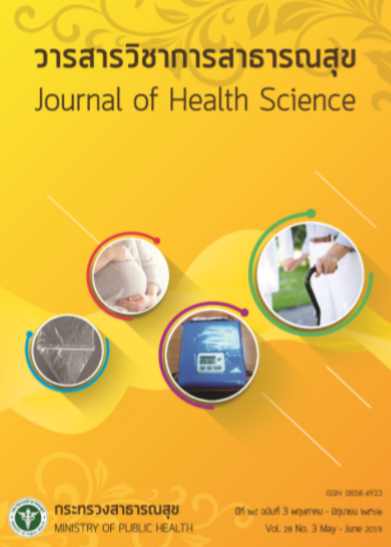การพัฒนารูปแบบคลินิกหมอครอบครัว ในเขตเมืองหนาแน่น จังหวัดสมุทรปราการ
คำสำคัญ:
การพัฒนา, รูปแบบคลินิกหมอครอบครัว, เขตเมืองหนาแน่นบทคัดย่อ
การวิจัยในครั้งนี้เป็นการวิจัยแบบเชิงคุณภาพโดยเน้นกระบวนการมีส่วนร่วม โดยมีวัตถุประสงค์เพื่อศึกษาและพัฒนารูปแบบคลินิกหมอครอบครัวในเขตเมืองหนาแน่น จังหวัดสมุทรปราการ โดยพัฒนาจากแนวทางการดำเนินงานคลินิกหมอครอบครัวของกระทรวงสาธารณสุข (3S) และแนวคิดของแมคคินซีย์ (McKinsey’s 7S Framework) ประชากรและกลุ่มที่ทำการศึกษา ประกอบด้วย ผู้อำนวยการโรงพยาบาล สาธารณสุขอำเภอ ทีมพัฒนาคลินิกหมอครอบครัวและทีมปฏิบัติการในคลินิกหมอครอบครัว จำนวน 30 คน โดยกระบวนการพัฒนาแบบมีส่วนร่วมใน 5 ขั้นตอน คือ ขั้นตอนการศึกษาบริบท ขั้นตอนกำหนดปัญหา ขั้นตอนวางแผนปฏิบัติการวิจัย ขั้นตอนการติดตามตรวจสอบและแก้ไขระหว่างการปฏิบัติงานวิจัย และขั้นตอนสรุปการวิจัย เครื่องมือที่ใช้ในการวิจัยครั้งนี้ประกอบด้วย การศึกษาเอกสาร รายงานการดำเนินงานคลินิกหมอครอบครัวบางแก้ว การสัมภาษณ์เชิงลึกและการสนทนากลุ่ม กระบวนการทำงานแบบมีส่วนร่วม การประชุมเชิงปฏิบัติการแบบมีส่วนร่วม และการสังเกตแบบมีส่วนร่วม วิเคราะห์ข้อมูลเชิงคุณภาพด้วยการวิเคราะห์เนื้อหา ทำการวิจัยในช่วงระยะเวลาเดือนเมษายน พ.ศ. 2561 ถึงมีนาคม พ.ศ. 2562 ผลการศึกษาและพัฒนารูปแบบ ได้รูปแบบการดำเนินงานคลินิกหมอครอบครัวในเขตเมืองหนาแน่น จังหวัดสมุทรปราการ (สมุทรปราการ 7 S Model) ดังนี้ (1) Strategy มีกลยุทธ์ ครอบคลุมมิติสุขภาพแบบองค์รวมต่อเนื่องผสมผสานตามหลักเวชศาสตร์ครอบครัว โดยมีกลยุทธ์สำคัญ 4 กลยุทธ์ (2) Structure การจัดโครงสร้างของอาคารและการจัดโครงสร้างของการประสานงานและจัดโครงสร้างชุมชนตามลักษณะเขตเมือง (3) Systems มีการจัดระบบบริการในคลินิกหมอครอบครัวและในชุมชน การจัดระบบสนับสนุนและการจัดระบบเทคโนโลยีสารสนเทศ (4) Staff มีการบริหารจัดการด้านบุคลากร การจัดโครงสร้างของทีมหมอครอบครัว (5) Skills มีการพัฒนาด้านองค์ความรู้ในการดูแลสุขภาพประชาชนด้านเวชศาสตร์ครอบครัว ระบบการให้คำปรึกษา และระบบการแลกเปลี่ยนเรียนรู้ผ่านกระบวนการ context based learning: CBL (6) Style การทำงานเป็นทีมด้วยกลไกการพัฒนาคุณภาพชีวิตระดับตำบล (พชต.) และการมีส่วนร่วมของชุมชนในการสร้างเสริมสุขภาพและการดูแลตนเอง (7) Shared values สร้างค่านิยมร่วมกันทุกระดับในการยึดผู้ป่ วยเป็นศูนย์กลางของการดูแลสุขภาพตามหลักเวชศาสตร์ครอบครัว ดังนั้นคลินิกหมอครอบครัวในเขตเมืองควรนำรูปแบบการพัฒนาไปเป็นแนวทางในการดำเนินงานเพื่อความสอดคล้องและเหมาะสมกับบริบทความเป็นเขตเมืองหนาแน่นต่อไปDownloads
Download data is not yet available.
ดาวน์โหลด
เผยแพร่แล้ว
2019-08-15
วิธีการอ้างอิง
ฉบับ
บท
นิพนธ์ต้นฉบับ
การอนุญาต
ลิขสิทธิ์ (c) 2019 Journal of Health Science - วารสารวิชาการสาธารณสุข

This work is licensed under a Creative Commons Attribution-NonCommercial-NoDerivatives 4.0 International License.







